Double Damage Games releases a true spiritual successor to Origin Systems’ Privateer, and in doing so gives every player a chance to live a life like famed space scoundrel Han Solo.
Released: Epic
Type: Single-player
Genre: Arcade Space-Combat
Developer: Double Damage
Publisher: Double Damage
Release date: 13 August, 2019


Imitation Is The Sincerest Form of Flattery
In 1993, Origin Systems released Privateer, a title that was spun-off from the company’s larger space-opera franchise, Wing Commander. Taking place in the same universe, Privateer put the player in the seat of a beat-down, pile-of-junk ship – a gift inherited from an uncle recently passed away – and tasked them with making a living. It was the dream of every kid who ever imagined being Han Solo: make your way in a cutthroat galaxy by trading, smuggling, or bounty-hunting in your very own space ship. Players could earn credits by trading commodities among needy star systems, hauling contraband for wealthy sharks, or hunting down dangerous adversaries. They could then spend their hard-earned credits on new ships, weapons, shields, and various other upgrades. Nestled among the offerings of the space station mission boards was a single-player narrative that drove the game forward when the player cared to engage it.
Since Privateer was released, the space-mercenary genre has suffered from a dearth of titles to carry it. The game did spawn a sequel three years after its release called Privateer 2: The Darkening. Unfortunately, it was created during the era when Full Motion Video became all the rage among developers. The combat in The Darkening – the core of the game – took a back seat to more passive, and expensive, cinematic cut-scenes starring a young (and relatively unknown) Clive Owen. The game played more like an interactive movie than the visceral space-opera of its predecessor. A third installment in the Privateer series never saw the light of day after the lukewarm reception that The Darkening received.
Digital Anvil tried to resurrect the space-mercenary genre in 2003 when they released Freelancer, a title developed by Chris Roberts, the same person responsible for the Wing Commander series nearly a decade earlier. Freelancer mimicked the core gameplay of Privateer – trading, smuggling, bounty hunting – but in an effort to appeal to a wider audience, it eschewed joystick support in favor of a mouse-driven controller system that was very similar to what No Man’s Sky uses today. Freelancer did not do well commercially, however, and because of its poor sales, developers have largely shied away from the space-mercenary genre since, turning their focus toward more realism-based space-simulations that offer deeper, more complex gameplay.
Enter Double Damage Games, a small indie studio with a clear affinity for the original Privateer. The developers make no bones about their love for the original Origin Systems classic, imitating everything from the arcade art design and dogfighting mechanics to the mission variations and naming conventions of systems on the galaxy map (as with Privateer, many systems, planets and space stations are named after US states and cities). The developers directly referenced Privateer in a preview video that showed up on YouTube in 2017, showcasing a starter ship that was a high-resolution copy of the same vessel from the original game.
It’s important to understand then, that Rebel Galaxy Outlaw is a clear and intentional imitation of Privateer. It knows exactly what it wants to be and works diligently to be the best version it can. Thankfully, it is also a bit more than a simple clone of an old title; it’s not just the same engine with a fresh coat of paint. It adds a few tweaks of its own to the recipe that Privateer created and the game is better for it.
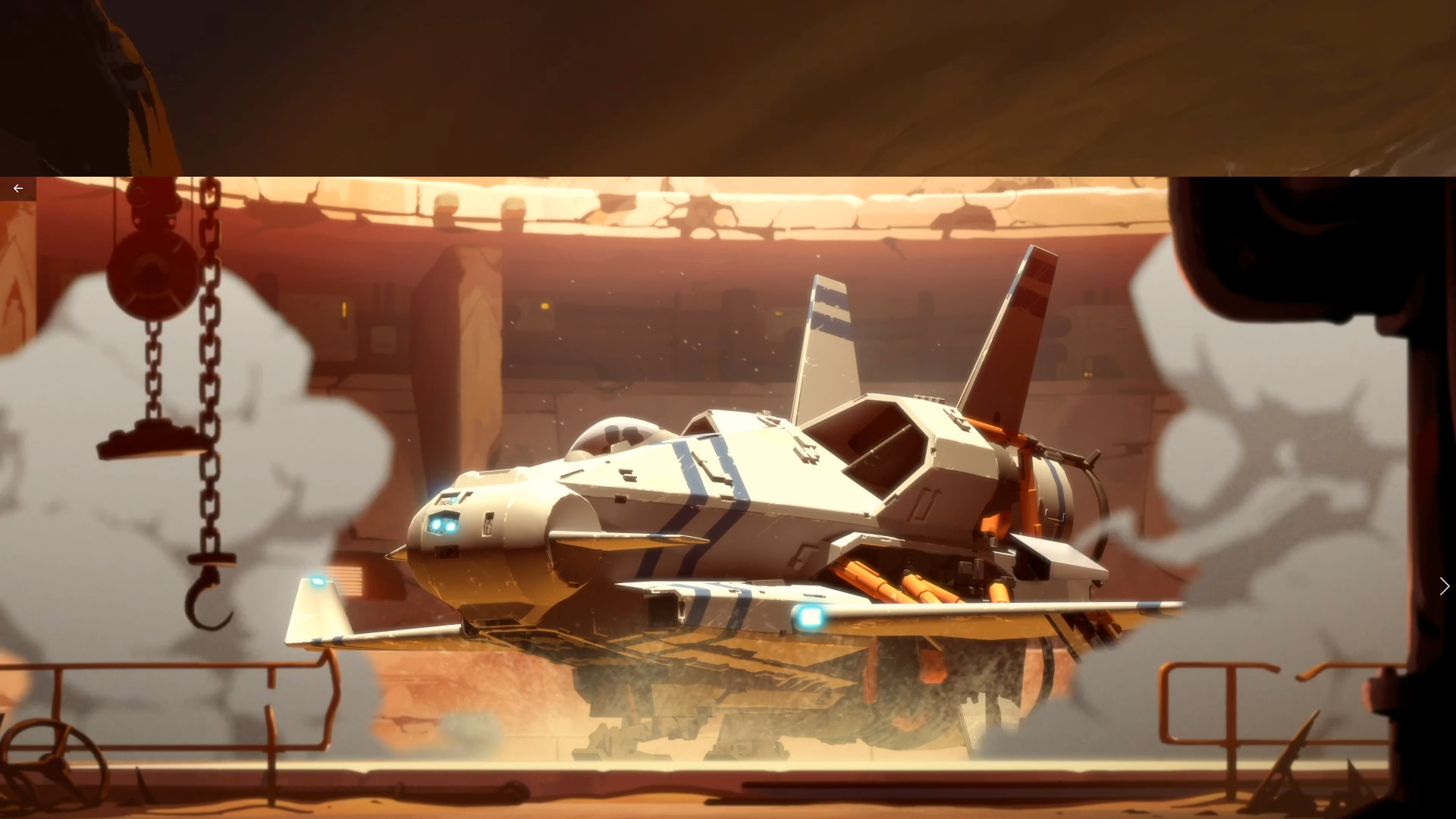
Story (Or, How You Never Get A Second Chance To Make A First Impression)
The game opens with a very well-crafted, animated cinematic that sets the perfect tone for an arcade-action space-combat game. We’re introduced to Juno Markev, a pilot who recently lost her husband at the hands of Ruth, a.k.a. “Ruthless”, a nefarious mercenary-type villain. She’s found the killer on a backwater planet, but her revenge doesn’t go as planned. During a dogfight, her fancy hot-rod ship flames out and crashes; a total loss. Juno walks away from the wreck, but is now without transportation. She resorts to the tried-and-true last-ditch effort commonly available to protagonists down on their luck: calling in a favor from an old friend. With a new ship secured – and a junker at that – she’s ready to take on the galaxy and seek revenge for her husband’s death.
The story plays out across several missions and works as a way to guide the player along, prodding them to earn credits and upgrade their ship. Each mission gets progressively more difficult and requires a more capable craft in order to succeed. Thus, the player will spend a considerable amount of time between plot missions working their own contracts, trying to earn the necessary credits for upgrades.
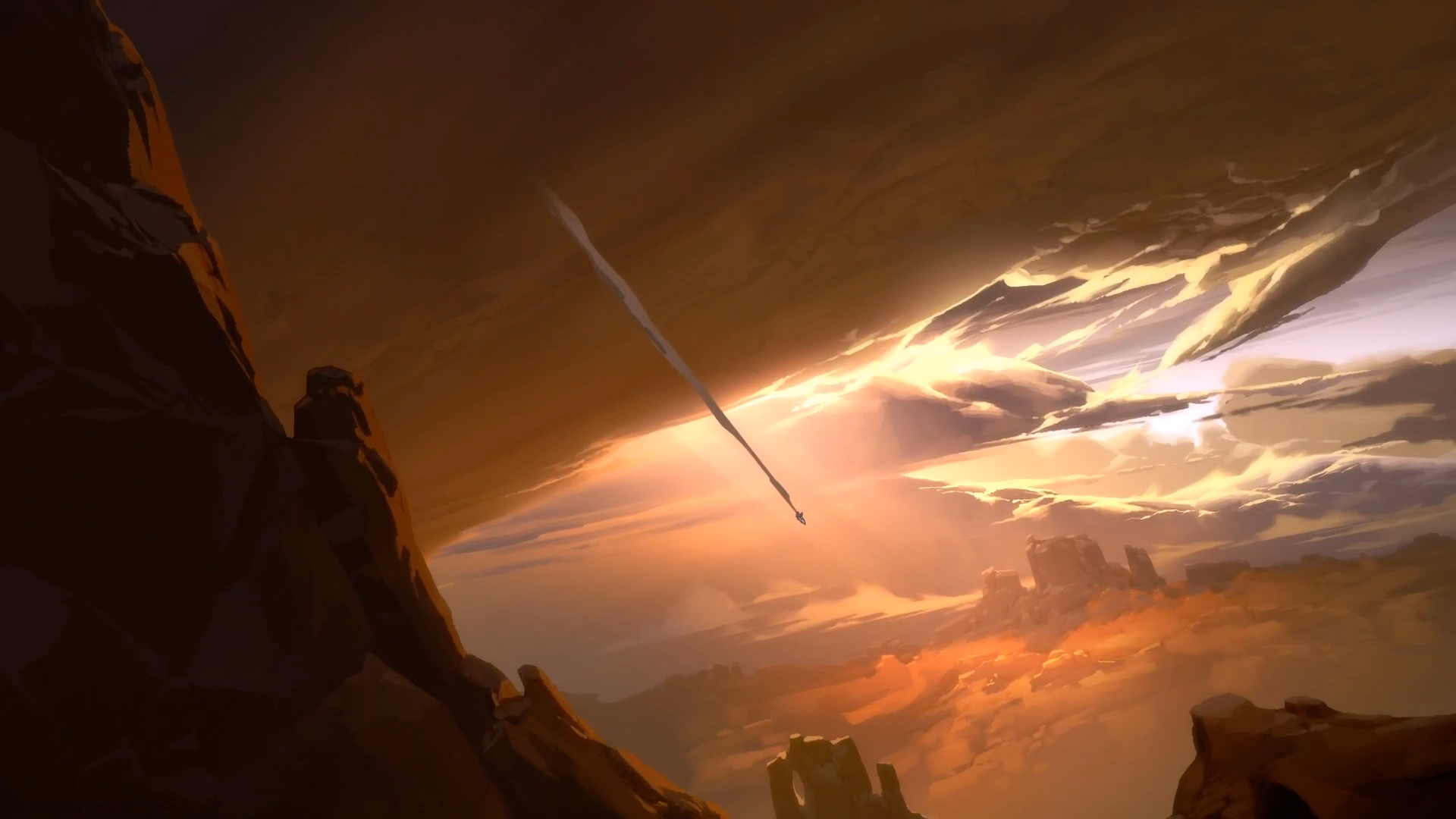
Artwork & Graphics
The artwork in the opening cinematic is fantastic. The whole sequence is reminiscent of the art style from games like Ash of Gods: Redemption, or the film Titan AE. It has an intentional comic-book feel to it. It’s a slick and visually attractive way to begin the game. The artwork in the opening sequence is so good, it’s a bit of a letdown that the rest of the game sequences (when not in the cockpit) fail to utilize it as well.
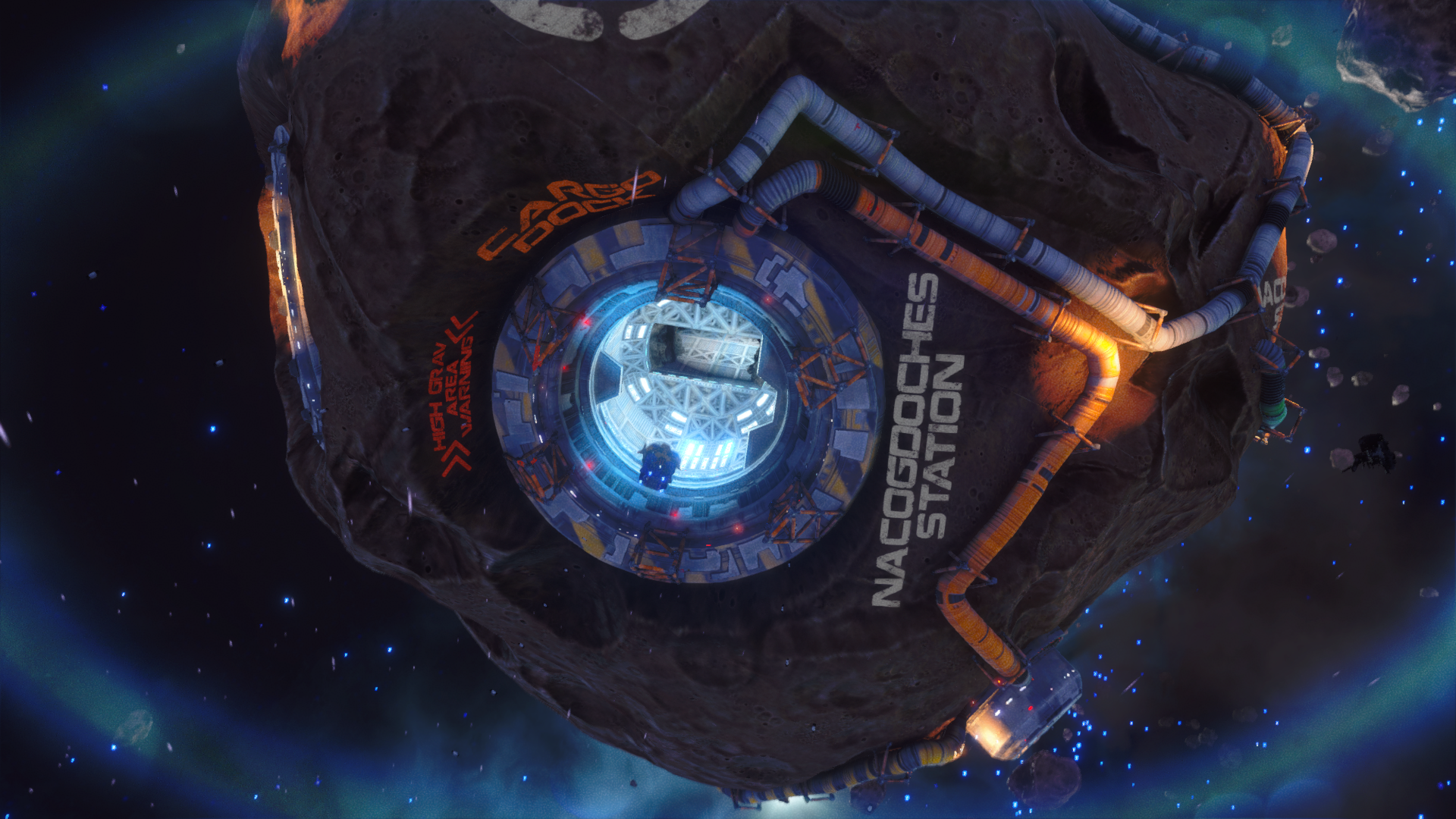
The majority of the game takes place in space, and here the developers have chosen a very colorful graphics palette that favors thick, deliberate fonts over thin lines and sleek designs. The end result is a game that looks, and feels, at all times, like the player is living in an arcade/comic-book world. At times it evokes the 1981 film Heavy Metal. It’s not the same kind of hyper-stylized animation approach as a title like Borderlands, but it’s definitely not striving for photo-realism either. Outlaw lingers somewhere in the artistic space between.
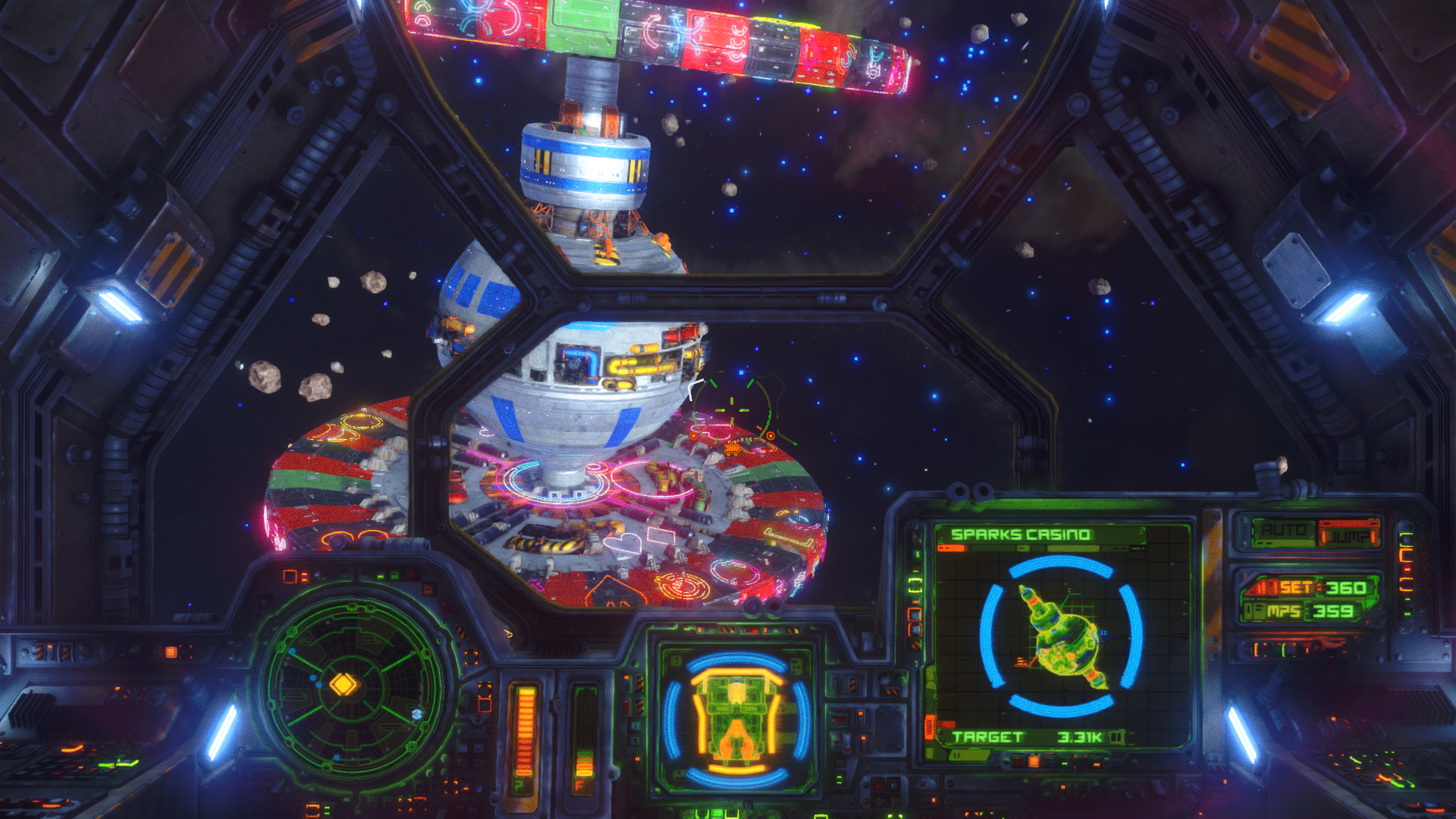
For the most part, the aesthetic works. The colorful space stations and ample lighting are a nice change-of-pace from the oppressive darkness and sparse surroundings that other spaces games employ. The art choices here give the game its own look-and-feel and help set it apart from other titles.
But the art style does have one drawback: the larger fonts and wider lines the game employs in the cockpit can leave the screen feeling cluttered and blocky. And while Outlaw is trying very hard show its love and admiration for Privateer, there is simply no reason for it to also look as if it was also made in 1992. If there’s a flaw at all with the game, it’s with the high-res graphics trying to emulate the low-resolution art quality of the early 1990’s.
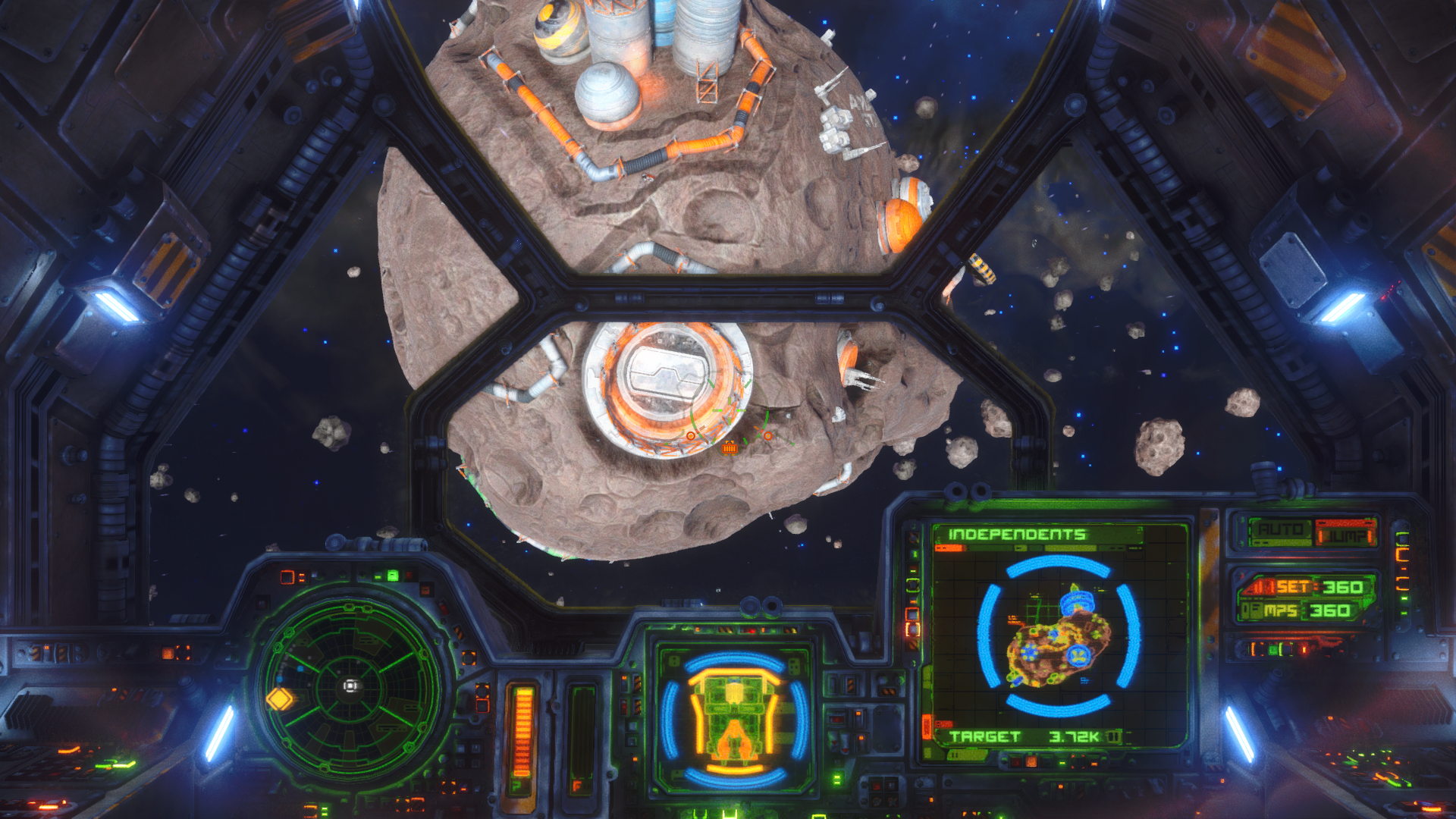
The interior of the cockpit – the various indicators, bar-graphs, and especially the radar – are negatively affected by the low-res art style. The player will spend a considerable amount of time glancing at the radar, in particular, while trying to track enemies and, unfortunately, the radar screen is a cluttered mess of square pixels. Ships at a distance, cargo ejected after an explosion, debris from destroyed craft – they’re all square dots lingering across the tiny radar screen. It’s as if the radar component was built by Minecraft Inc. The end result is that the in-cockpit graphics just don’t look as good as they could, or should. Functionally they’re fine, but they strain the eyes.
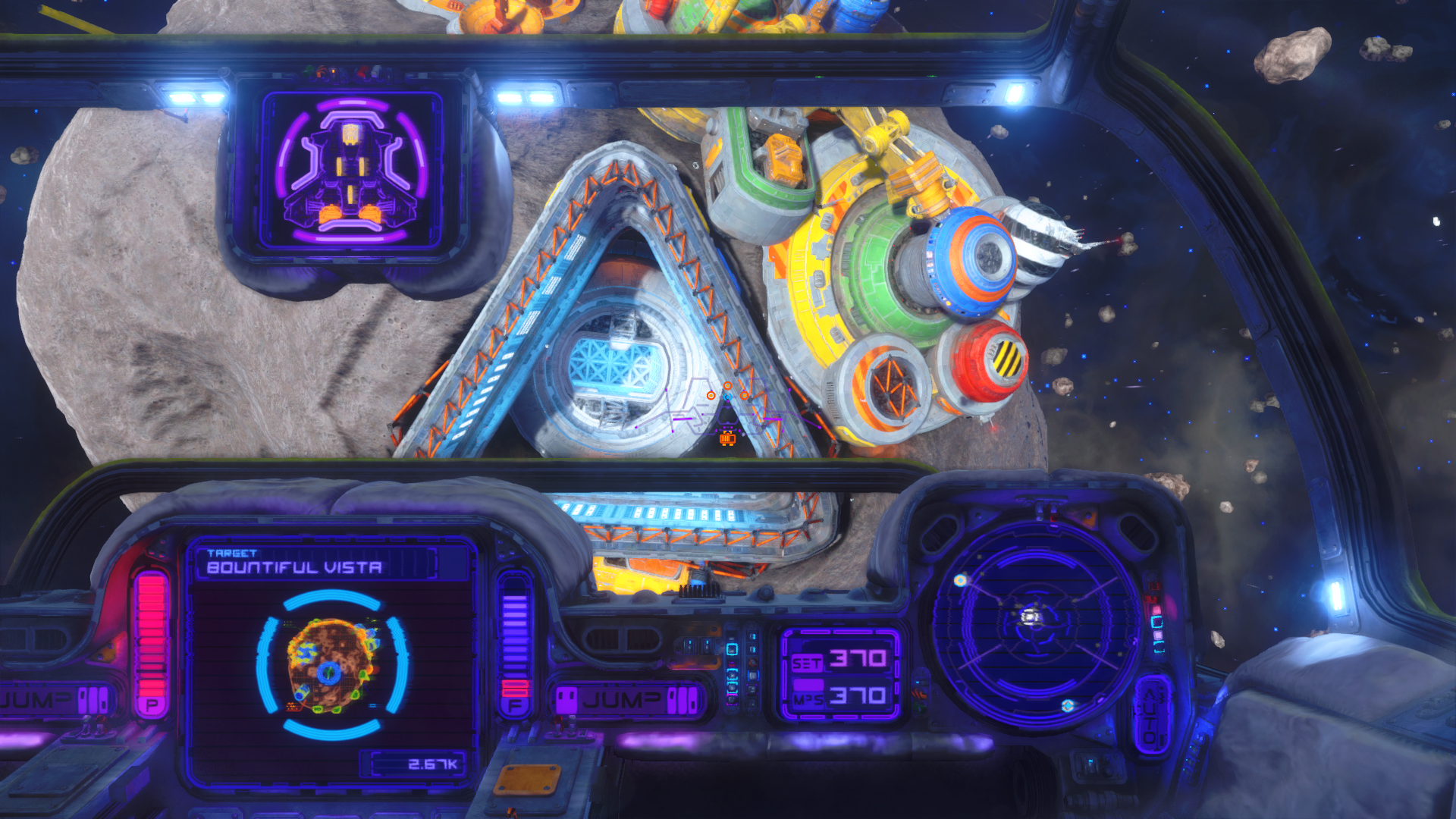
It is easy to understand what the developers are going for here: they want to the game’s graphics to convey the game’s play and tone; this is an arcade title, first and foremost, and not a serious simulation. But the arcade feel would not have diminished with higher resolution visuals in the cockpit. It doesn’t need to look like Elite Dangerous – nor should it – it just needs to look much better than it currently does. Too often, the game gives the player the sense they are playing a title in old-school 640×480 resolution when in reality they’re playing the game at 1920×1080.
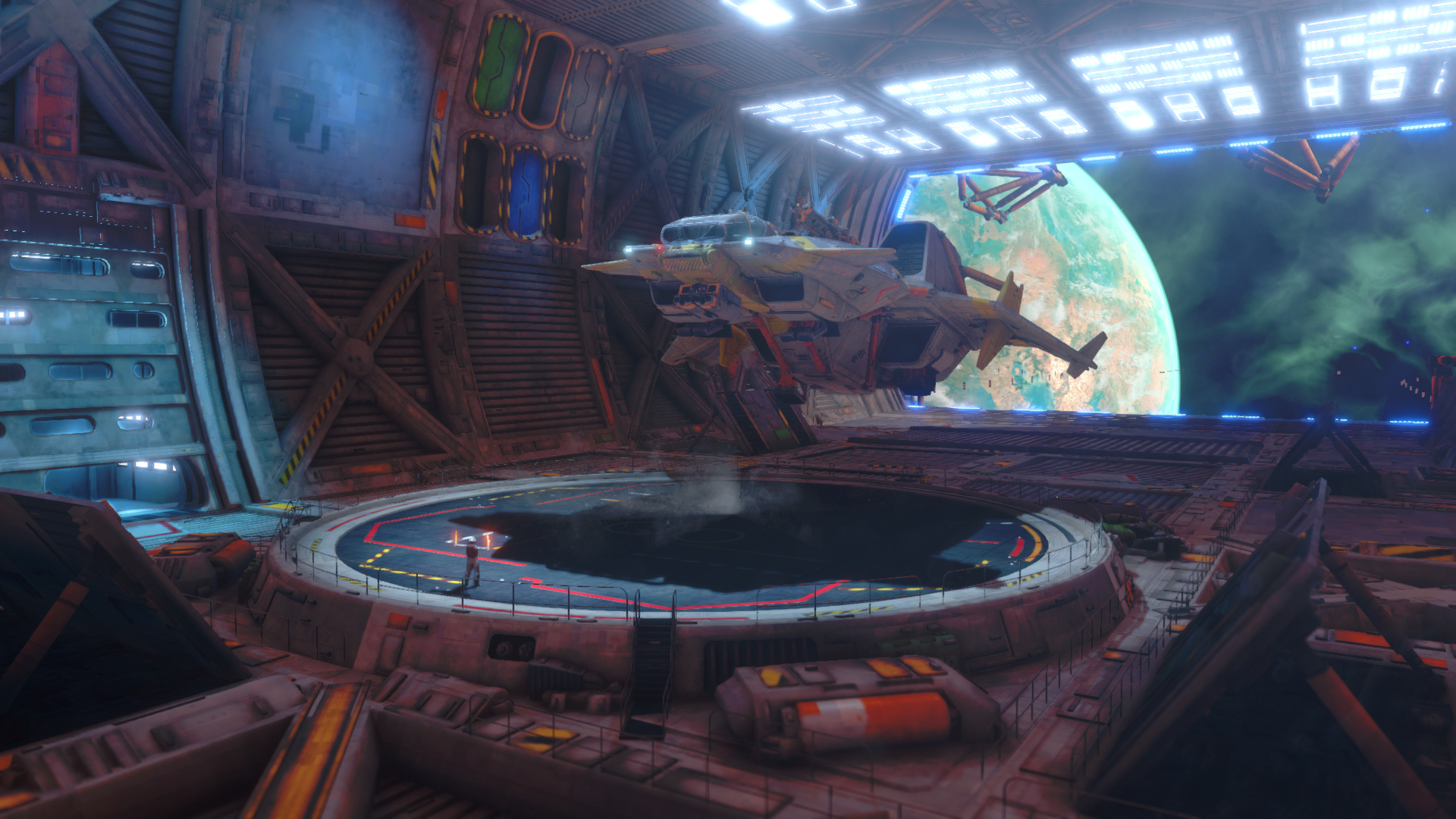
Game Play (Meat & Potatoes)
Outlaw is an arcade game and makes no bones about it. And that’s a good thing. It wants the player to have fun flying around in space and blowing stuff up. To that end, all the boring and time-consuming bits of space-combat games have been removed, or at least, worked-around.
As an example: the idea of spending minutes (or hours) traveling through empty, dead space, just to get from point A to point B, is discouraged in Outlaw. The player can engage in such boring flight if they want, of course, but there’s no need to. The developers have provided a short-cut (autopilot & sub-light speed) so that players can bypass long, empty sections of space, and instead of remaining engaged in the fun and interesting parts of the game. Namely, space combat.
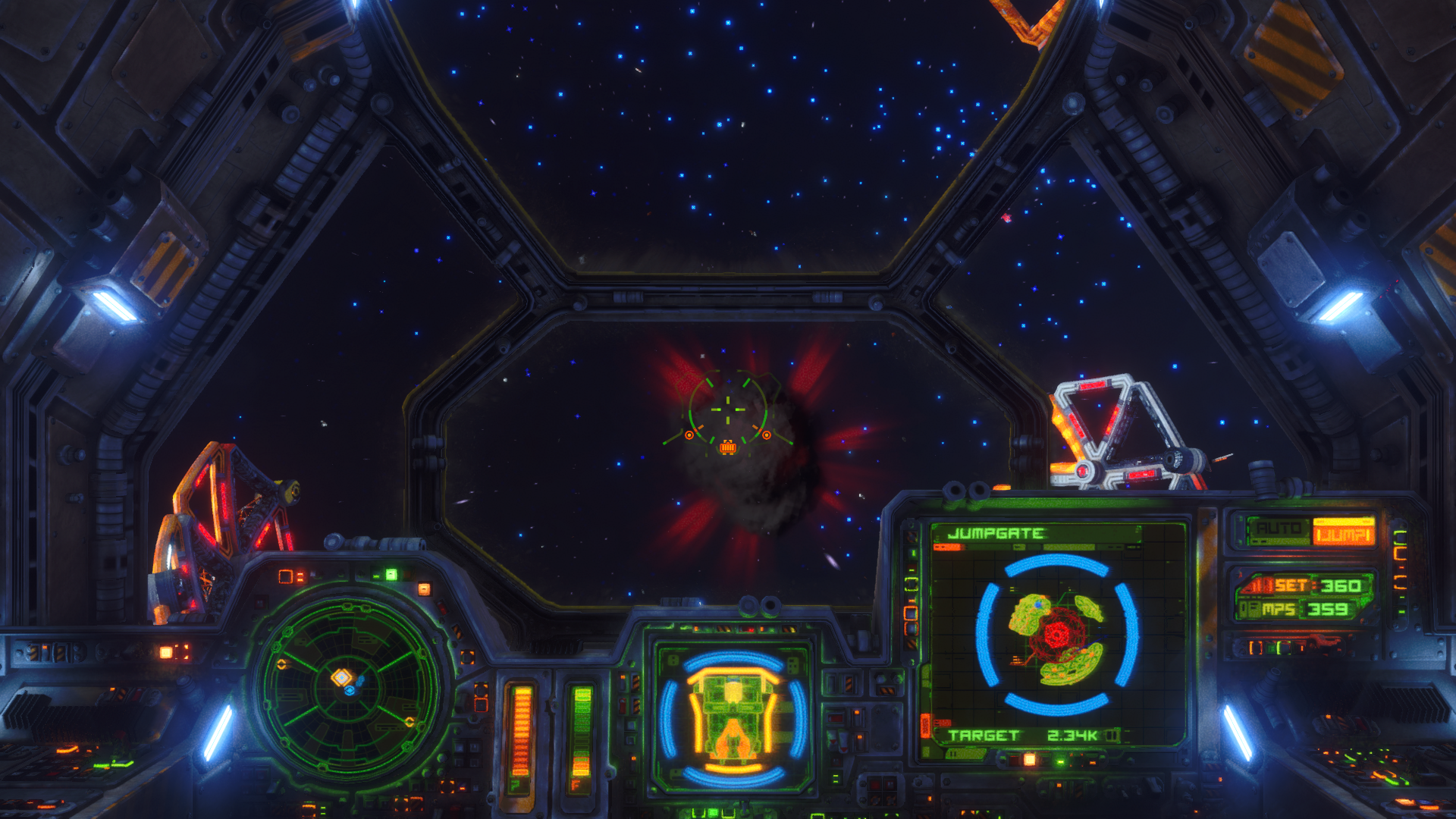
Combat is the meat-and-potatoes of Outlaw. Dogfights are visceral and frenetic affairs. They are fun, engaging, and colorful. Missiles ignite brightly and leave very satisfying smoke trails on the way to their targets. Ships spit smoke and flame as they take increased damage, hurling debris into space as their hulls lose integrity (pro tip: it’s a good idea to swerve after blowing up an enemy, especially if they are close, as debris from their ship will do damage to the player’s vessel).
One of the particularly satisfying aspects of the combat is manner and degree with which the player’s own ship can become damaged during an intense battle. When shields fall on one part of the ship, the hull’s armor will then take damage in that area. Lose enough hull integrity, and critical ship systems will become crippled as well. The ship’s windows will crack, obscuring the view; screens will flicker off-and-on; static will sound. Even the ship’s maneuvering capabilities can become compromised, creating situations where the player may be able to turn their vessel to the left, but not to the right. A wounded ship creates some interesting choices for the player – find the nearest port, and make repairs, or try and make one last jump to the destination system and get paid? In the early game, cash flow will often dictate the risks a player is willing to make.
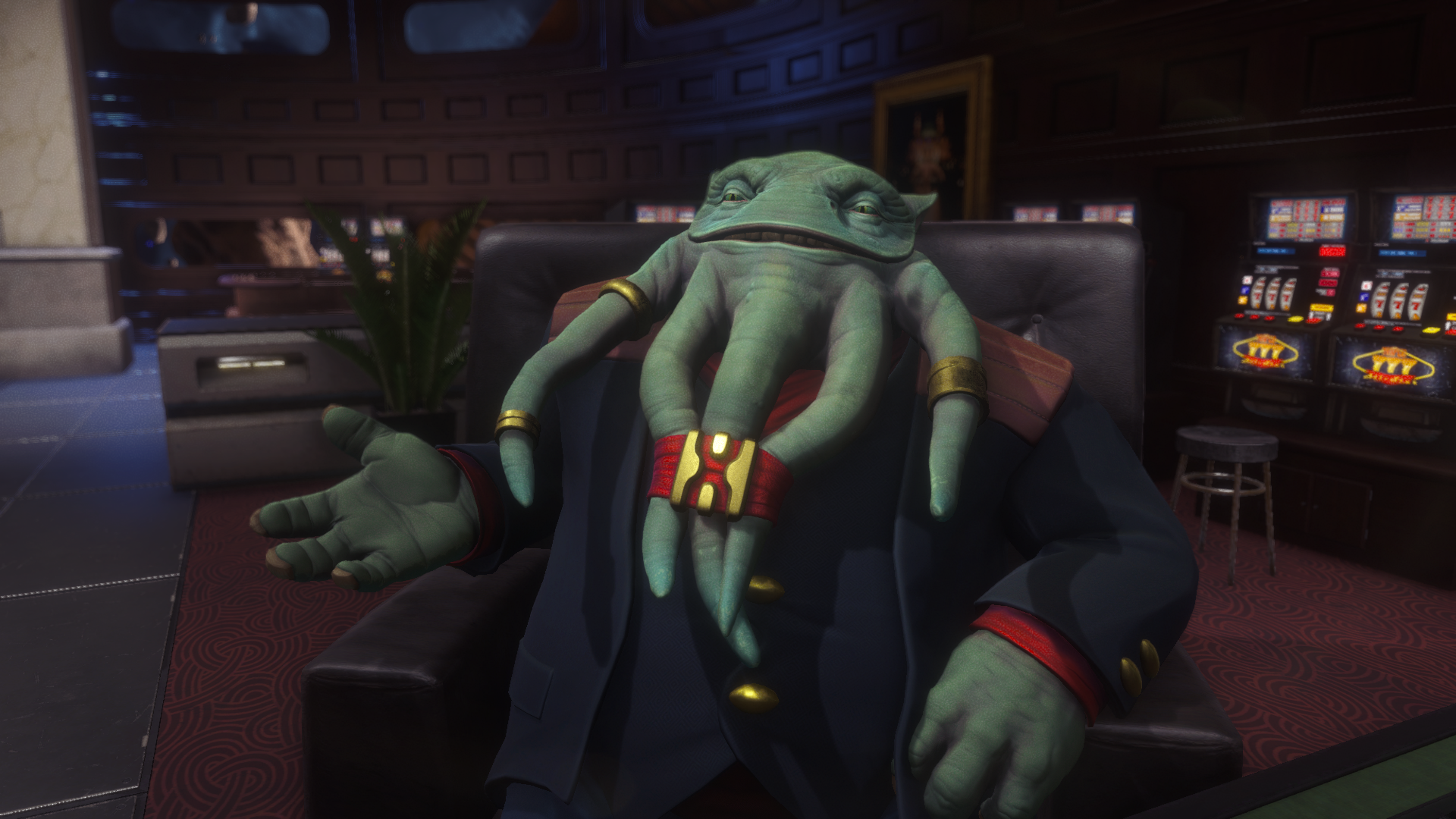
Missions
One of the first things the player is going to want to do when they hop into their boxy Platypus junker is upgrading to a better ship, and upgrade the components on their ship. The starting vessel is a meager craft with limited capabilities and can only handle the easiest missions. The player will need more and better weapons, shields, and power if they’re going to advance the story and accept the most lucrative contracts.
To facilitate this, every spaceport has a Mission Board, and the player can accept up to four missions at a time to aid them in earning credits. The missions are limited to a few basic types, such as: kill pirates, destroy mines, ferry cargo, rescue freighters, patrol between a few waypoints, etc. These mission variants are more-or-less lifted directly from the Privateer blueprint, but Double Damage Games has added a few wrinkles of their own.
One of the more interesting additions is the “distress call” mission. Quite often, the player will have their auto-pilot interrupted by a distress message (ignoring the interruption of distress calls is something that can thankfully be turned off in the ship’s menu). These interruptions come in a wide variety of flavors. Sometimes the distress call can require warding off pirates and saving a freighter, but other times the call can be as simple and easy as “pairing up” with another ship and escorting a freighter to the nearest jump-gate, without any kind of violence at all. The rewards for these random missions can range from credits transferred directly in the player’s bank account to goods jettisoned into space by the freighter, which will require the player to own a tractor-beam in order to cash in (pro tip: save a few units in the cargo hold for tractor-beam rewards).
In addition to the regular Mission Board that every station possesses, there are also a Merchant’s Guild and a Mercenary’s Guild that the player can join, each for a fee. The guilds offer their own missions that are frequently more lucrative, and dangerous, than the regular mission board fare. The guilds don’t have offices in every spaceport, so players need to keep track of the office locations if they want to accept contracts from them.
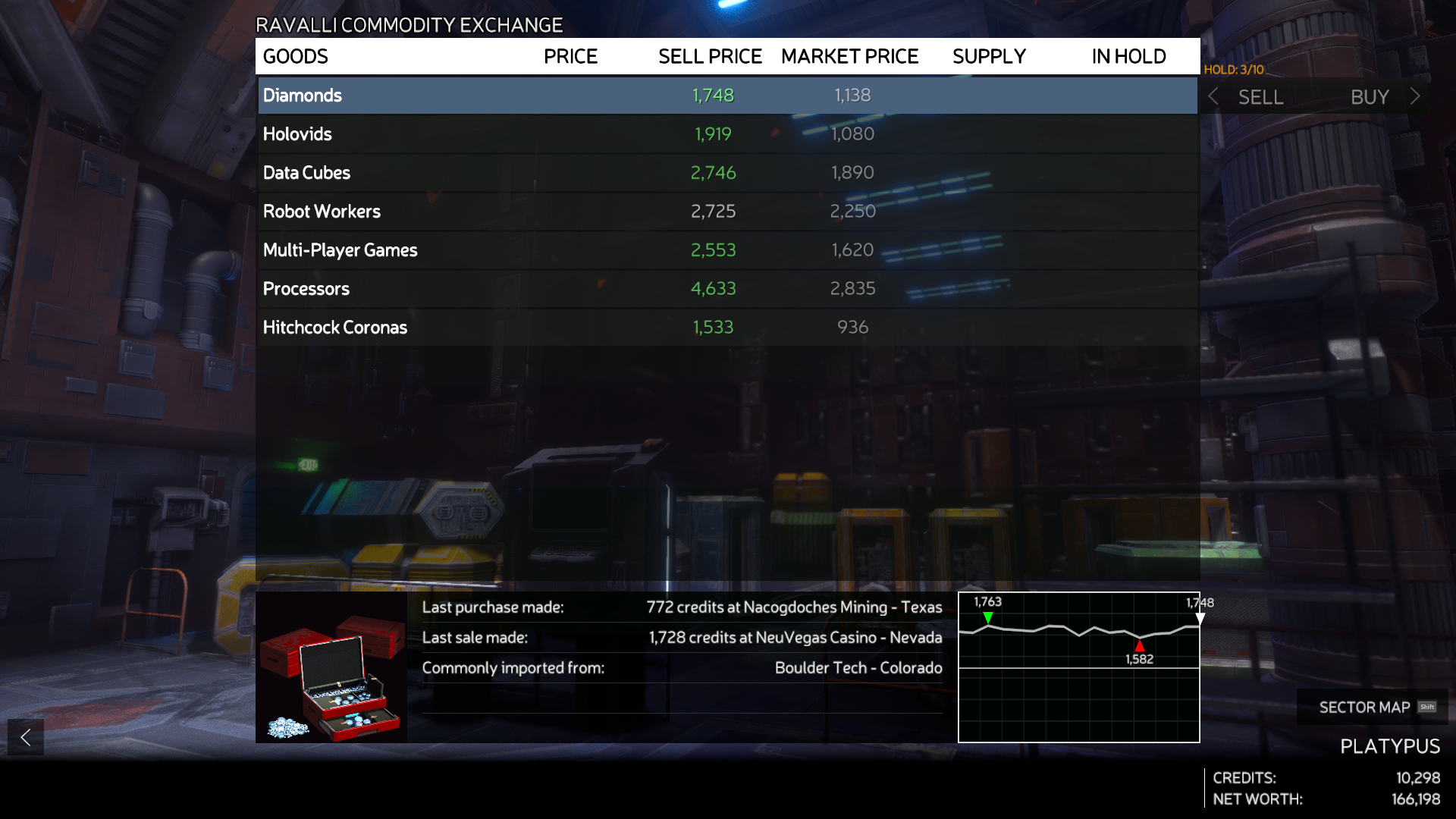
Trading
While the mission boards provide a built-in, directed way for the player to earn credits, there is another route to financial wealth: Trading. This is something Outlaw does quite well.
Spaceports have a limited set of items they deal in; no spaceport has everything. Many spaceports have a specialty, such as Robotics or Whiskey, and it is here where the player will find the largest supply and cheapest prices on such items. Turning a profit then becomes a matter of finding another spaceport somewhere else in the galaxy that will purchase the goods for a considerable margin.
The task for the player is to figure out where items can be bought and sold for the greatest profit. Where is the best place to buy Robot Workers, and where is the most reliable place to sell them? Prices fluctuate as goods are bought and sold on the stations, creating a loosely dynamic economy. The interface will tell the player where they last bought and sold a specific commodity (and for how much), but it doesn’t track the totality of the complex trade system beyond that. It is incumbent upon the player to track their successful trade routes (an Excel spreadsheet works quite well), and to remember where they can get large quantities of specific goods for cheap prices.
The trading system also ties in nicely with the mission board system. Missions from the General Board, or the Merchant’s guild, will often ask the player to source specific items. Bring 6 tonnes of Whiskey to Planet A; bring 11 tonnes of Robot Workers to Space Station B. These missions become easy money when the player knows where to find large, cheap quantities of the items in question and the safest routes for delivering them.
In addition to the legal trade goods, there are also Black Markets. This is where the smuggling angle of the game comes into play. Black market commodity boards are the only places in the galaxy where the player can sell contraband. Some Black Markets are located on pirate stations and will require good standing with pirates factions in order to do business. Other Black Markets are neutral and will do business with the player regardless of faction affiliation.
Players can use a tractor-beam to haul in cargo after a battle. Pirates frequently drop illegal contraband. If a player can manage to avoid the scans of police patrols en route (or outrun their ships), selling contraband at a Black Market can be quite lucrative. In addition, players can also purchase smuggler holds. These cargo spaces are impervious to police scanners, but can only hold a very small amount of goods.
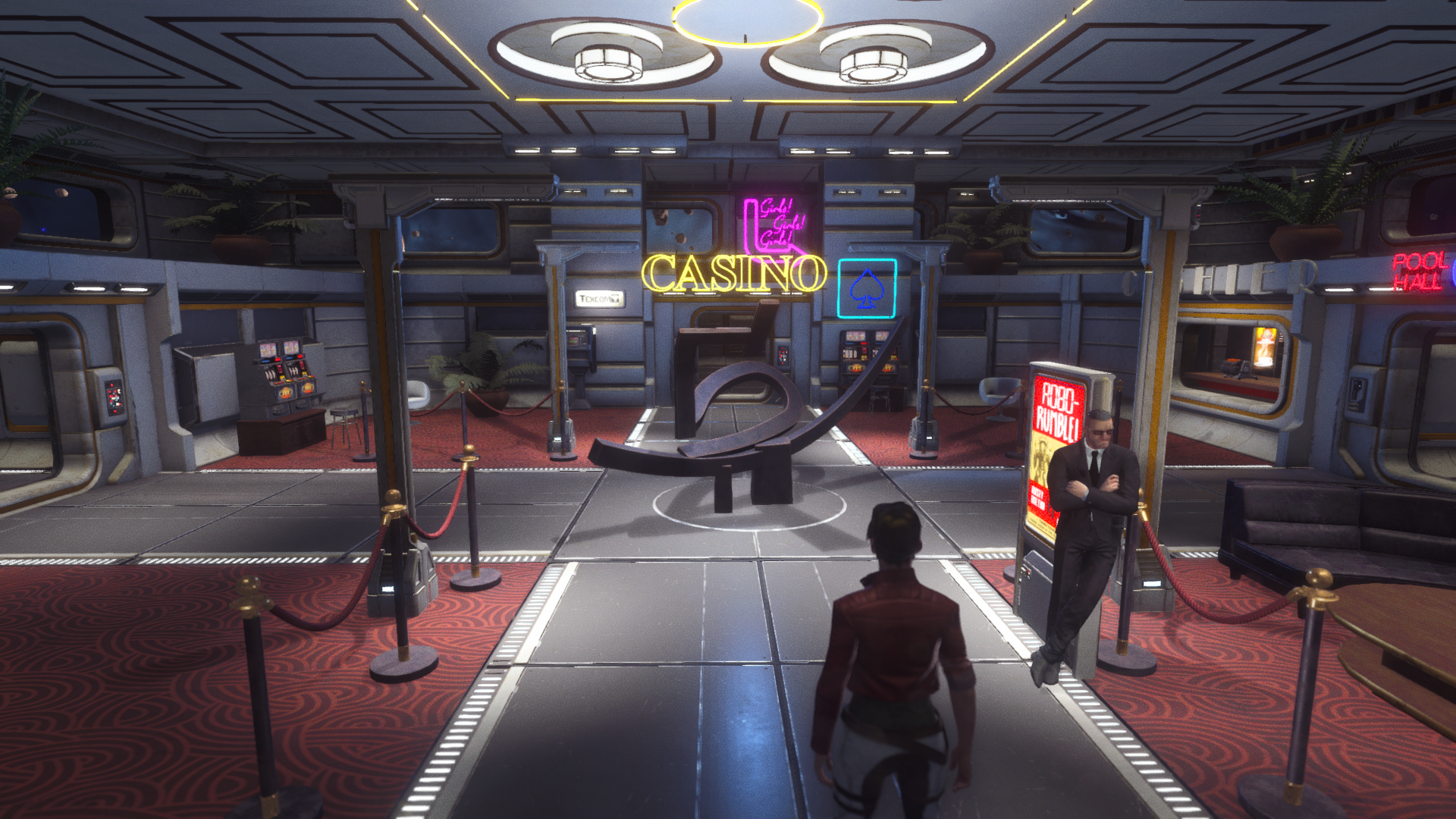
A Bevy Of Options
One of the more pleasant surprises of the game is the number of customization options it has.
It starts with the launcher window, which houses a host of graphics options the user can easily tweak before firing up the game. What’s particularly nice is that it supports three windowed modes right out of the box: Full-Screen, Windowed, or Full-Screen Windowed mode. This is a nice touch, to provide all of these modes available right from the start, without the user having to jump through any hoops, or edit any .ini files. And really, this sort of configuration should be a standard in games by now. It’s refreshing that Double Damage Games understands this.
Similarly, the game provides several different options for music as well. There are check-boxes for custom music, streamer-friendly music, and even a configuration setting so the user can point the game to specific directories where it can utilize MP3 files. And what’s more, there are multiple custom directory paths for different contexts. Thus, the user can specify one folder of music files to play when they’re interacting with a space station, and a different folder of music to play when they’re in the middle of combat. The myriad music configurations are a welcome addition to a title such as this, and something that other game developers would do well to emulate. There’s nothing quite like blowing up pirates to the sounds of one’s favorite metal bands (or whatever style of music the user prefers).
Finally, the game supports a wide array of input devices. Mouse and keyboard, gamepads, and HOTAS joysticks are all supported. Even No Man’s Sky cannot claim that feat, and it’s been out for several years. The HOTAS support is particularly nice, although configuration can be a little bit overwhelming. There are a large number of commands to potentially map, and a player may not initially understand which commands are the most valuable and useful to have mapped to their joystick, or even what each command does. There is some trial-and-error involved here in getting a suitable mapping configuration setup, but once established, it makes all the difference.
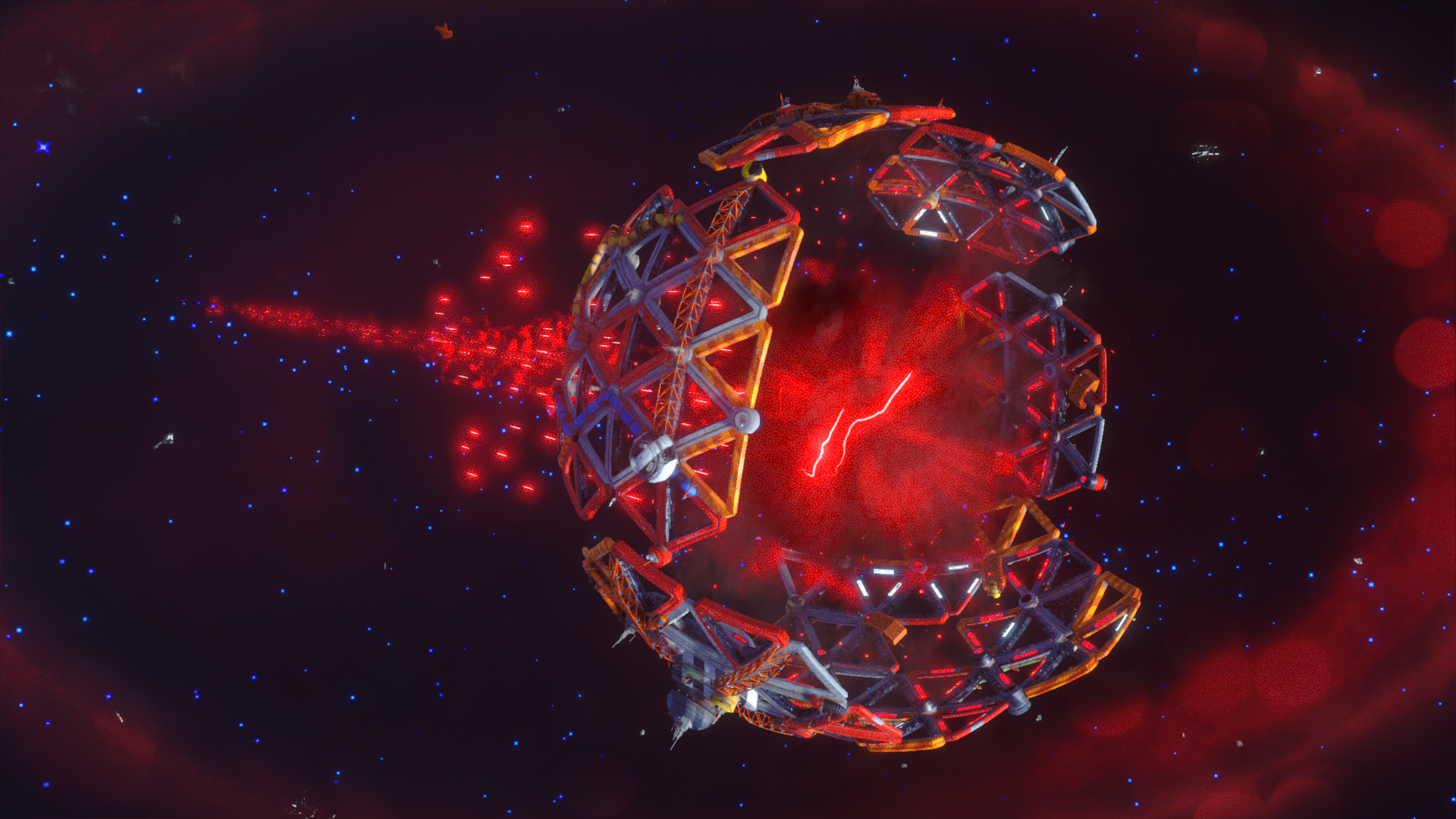
Game Modes
Outlaw provides several different game modes to the player. These don’t affect difficulty (enemies don’t get easier or harder). But they do affect certain starting equipment and certain gameplay features. Specifically, the modes affect the assistance that is given to the player. The specifics for these game modes, fortunately, can be found on the developer’s website.
The game offers two main types of assistance to the player: flight assistance, and aim assistance.
Most players are familiar with aim assistance from other game genres, namely first-person-shooters. The game will train the guns on enemies if the player gets “close enough” with the reticle. Even when this mode is on, not all weapons in the game will take advantage of it.
Flight assistance is a little different, and quite neat. If the player holds down a specific button after targeting a ship, an invisible tether will be created between the player’s ship and the locked ship. It’s a sort of invisible grappling hook, if you will. Where the locked ship goes, you go, and your ship will do its best to match the targeted ship’s speed. For novices to the game, this ability is quite handy, especially when fighting multiple enemies where the player may struggle to keep their primary target in range of the ship’s limited viewport. Ships can turn quite rapidly, and using the tether is a great way to keep the player’s ship trained on their target.
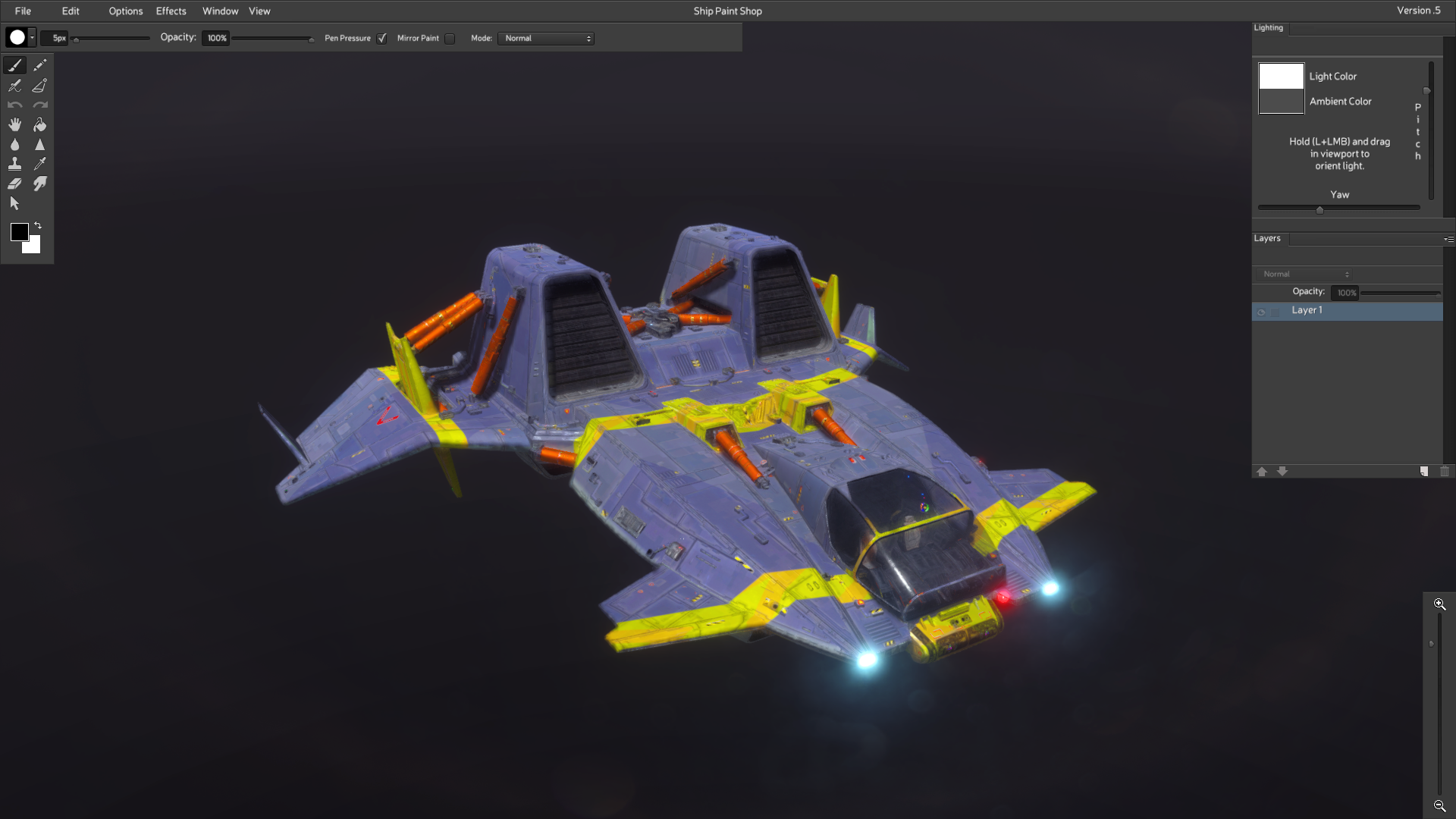
Ship Customization & GIMP/Photoshop
Customization is a frequently requested feature in many game genres. The space-combat genre, in particular, is fertile ground for such a feature. After all, what could be a better candidate for customization than a ship?
It is not surprising then to find that Outlaw sports one of the most fully-featured paint-shops ever placed into a video game. The developers have essentially embedded a lightweight GIMP/Photoshop-caliber graphics suite within the game itself.
For people familiar with graphical tools like GIMP and/or Photoshop, and its myriad features and manipulation capabilities, this may come as a pleasant surprise. There’s a lot of power in a paint-shop such as this. But it does come with one rather large drawback – it’s not entirely accessible to people who are unfamiliar with such tools. The power inherent in the tool requires some skill to use. Users who are not adept at using such editing tools may have trouble getting their ship’s paint job to look the way they want.
That said, its easy to understand why the developers went this route. Skilled users are going to have complete control over their ship’s paint job, and should be able to turn out some rather nice designs. And since the end result gets written to a single DDS file, it’s entirely likely that such files and designs will get uploaded to web sites and passed around to other players. Want a cool design for your ship? Just find someone who is skilled at making them, download their DDS file, copy to your game folder and voila: a new paint job.
In addition to the fancy paint shop, the developers have also stated (on their FAQ) that a modkit will be released post-launch, providing users with the ability to mod ships. What degree of modification is still unknown at this time, but this addition promises to keep some users very busy with the game long after its release.
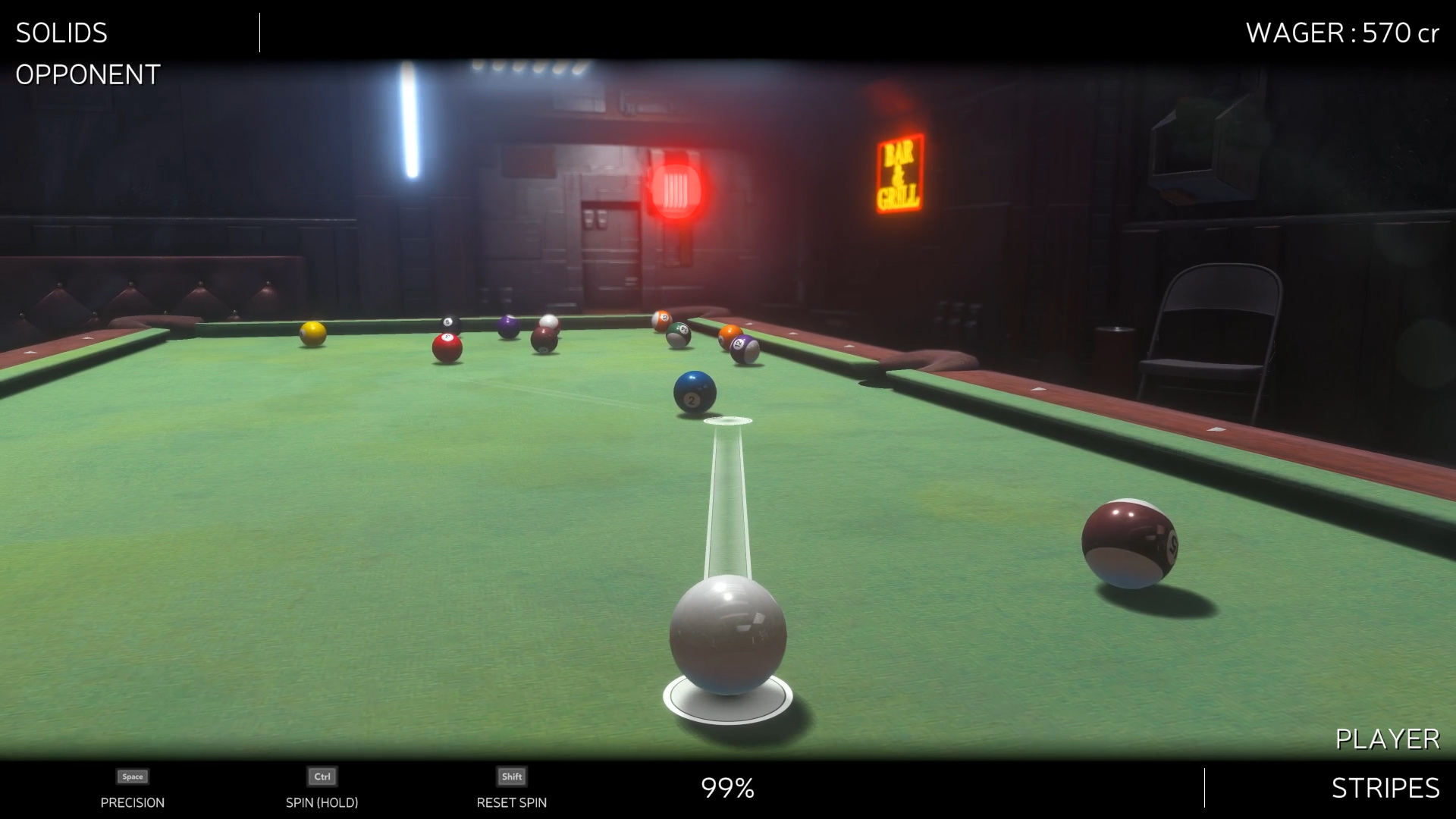
Want To Bet On It?
Dog-fighting comprises the vast majority of the game’s play. This is not a bad thing, but it can become a bit monotonous after a while. Fortunately, Outlaw provides some neat mini-games to break up the action. The mini-games range in variety from simple arcade stand-ups (like a knock-off of the Atari classic, Asteroids), to electronic slot-machines, to fully-rendered affairs, like pool. The number and types of mini-games available vary from station to station.
The pool is particularly good. It’s a really fun, and unexpected, addition to the game. Each match involves a wager of some sort, giving the player a chance to earn a few credits or perhaps valuable cargo. Unlike the electronic slots or the dice games, the pool isn’t totally random. So the player’s own skill has some influence here, and I found it to be a really fun way to earn a few extra credits while taking a break from the frenetic play of space-combat.
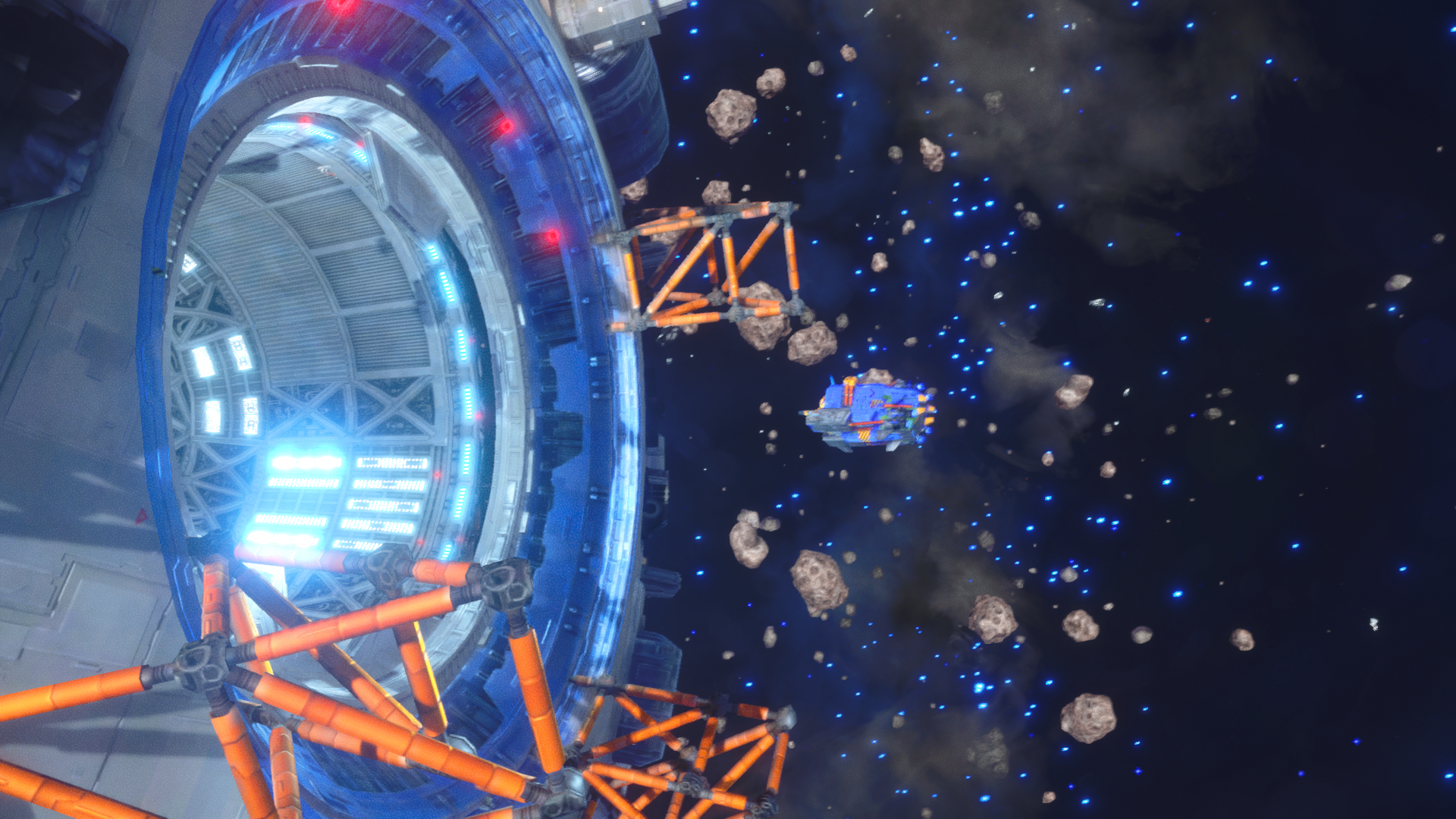
The Fault In Our Stars
The game isn’t without its issues, but overall, they are very minor and have a limited effect on the overall quality of the game.
As stated previously, the low-res graphics in the cockpit UI are a detriment. The radar is difficult to look at and wears on the eyes. This is the game’s number one issue. The cockpit just doesn’t look as good as it could. The problems with the game’s low-resolution cockpit become compounded when dealing with some of the game’s other flaws.
For instance, the story-driven missions in the game are always active on the radar. This is a problem because the radar is not high fidelity enough to handle it well. Given the blocky graphics of the radar and the large icons the game uses to convey information, the always-active story missions become a further clutter and hindrance to the radar UI. The player can mark certain missions as “primary”, giving them a slightly different accent, but what they cannot do is make the plot missions inactive. The game would benefit, greatly, from allowing the player to determine which missions they want to display as active on the radar. Being able to mark each mission as active, or inactive, would be a huge benefit.
This would also ease navigation, especially when making dangerous runs across hostile sectors. It is possible to throw the bulk of a ship’s energy into the engines, for instance, and use the increased power to outrun hostile enemies. This is particularly useful when the player wants to quickly traverse several sectors and sell-off certain cargo (contraband, for instance). The problem is, the cluttered radar screen inhibits the player from quickly identifying the correct direction to fly.
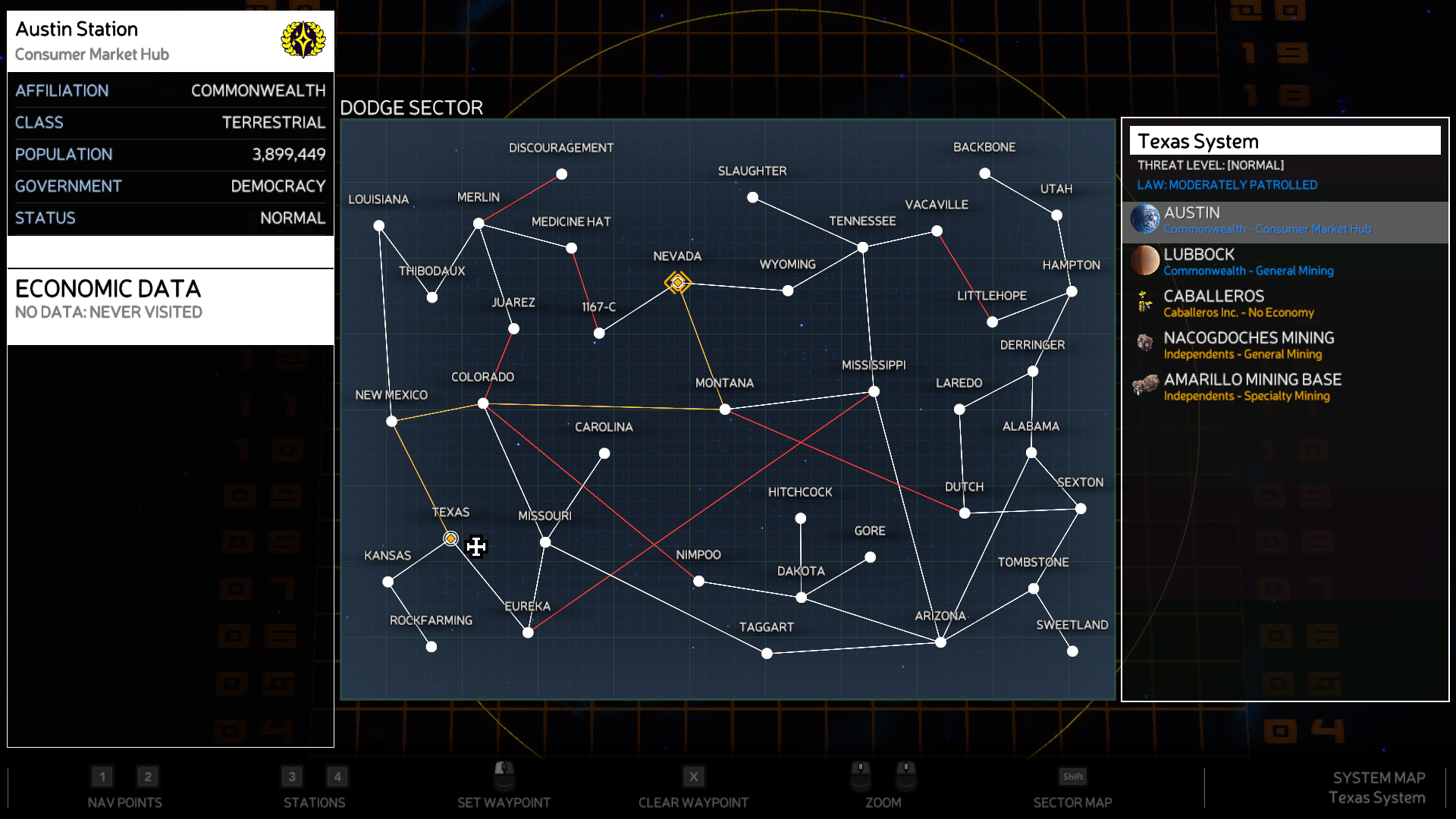
Another problem is the galaxy map itself. The map is good enough, but the secondary panel is a problem. The player can select a system and open up a panel on the right-hand side of the map that displays all of the planets and space stations in the system. This would be fantastic for the user since the detailed screen shows the types of commodities the planet or station buys and sells, except the panel prevents the player from scrolling through any of its entries. The screen defaults to one selection only – whichever planet or space station sits at the top of the list. If this is intentional or a bug is unknown, but it is certainly a wasted opportunity to provide valuable information to the player via the galaxy map.
The other problem with the game – and I hesitate to critique this aspect of it because the game really is fun – is the space flight itself.
Flying in dead space is always a visually boring affair. Outlaw remedies this by placing asteroids and other ships around the player in most locations of note, creating an environment that feels more active and alive. The other objects don’t just serve as clutter though; they help give the player’s eyes a reference point so they can see that they are actually moving through space. The problem is, the velocity feels sluggish. Compared to a game like No Man’s Sky, the ships in Outlaw feel downright slow.
That is, until the player starts trying to track an enemy in their cross-hairs. Then the ships suffer from the problem of turning far too quickly most of the time.
The sense of velocity and spatial distance in the game just doesn’t seem as fine-tuned and balanced as it could be in order for the dog-fighting to feel at its best. There are times when the mechanics feel more or less proper, such as when battling huge pirate cruisers that lumber slowly through space using their multitude of turrets to mow down pesky fighters. But other times, the speed with which certain ships turn seems at odds with good dogfighting mechanics. LucasArts encountered this same issue when developing the multiplayer game X-Wing vs. Tie-Fighter in 1997. Their solution was to couple turn-speed inversely to ship velocity. In order to make a fast turn, the player had to throttle down. The overall effect this had on dog-fighting was positive; flight and maneuvering felt smoother and worked better. Outlaw’s flight and combat mechanics are good enough – and certainly far better and more entertaining than some contemporary titles, like No Man’s Sky – but they feel as if there’s still a little room for improvement.
Final gripe: the game has no user manual. This isn’t really much of a problem; user manuals are a thing of the past, an artifact to a bygone era of gaming. Double Damage Games acknowledges this and has provided a solid tutorial on YouTube so new players can get their head wrapped around the entirety of the game’s systems in short order. Still, a PDF would have been a really nice touch.
It is worth repeating here: none of these issues impact the game’s quality very much. It’s still an incredibly fun romp in space, and it looks pretty fantastic in almost every way (save that darn low-res radar).
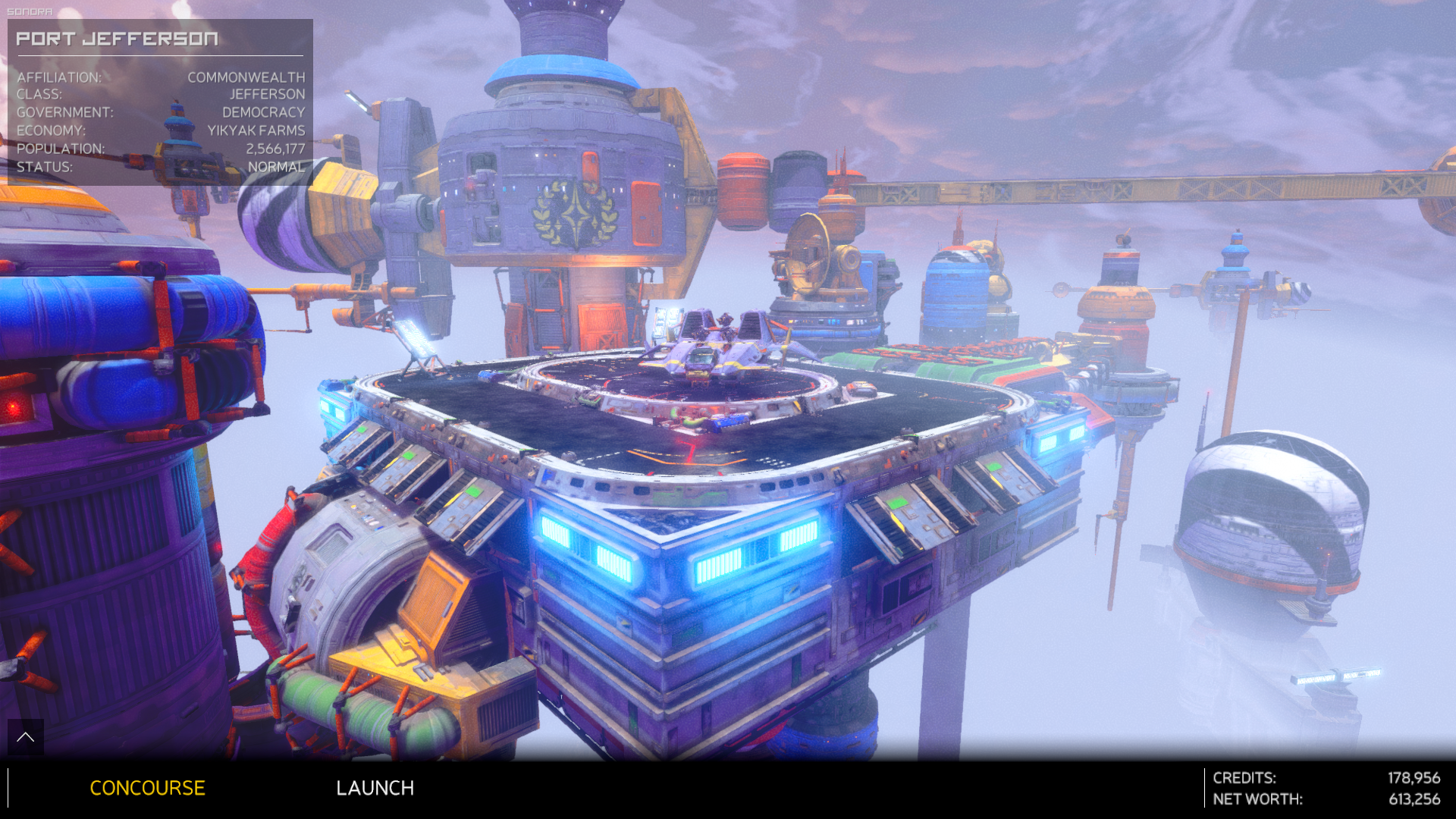
Verdict
In a genre occupied by the likes of more serious titles such as Elite Dangerous, No Man’s Sky, the X-series of games, and the upcoming Star Citizen, Rebel Galaxy Outlaw carves its own space with a deliberate aesthetic and focused, arcade-action gameplay. The title will appeal to anyone who likes the idea of blowing things up in space and progressing through a narrative at their own pace. It should also be a consideration for players who want to adventure in space but shy away from more complex games like Elite Dangerous. Outlaw is accessible, offers a high degree of customization, and is downright fun to play.

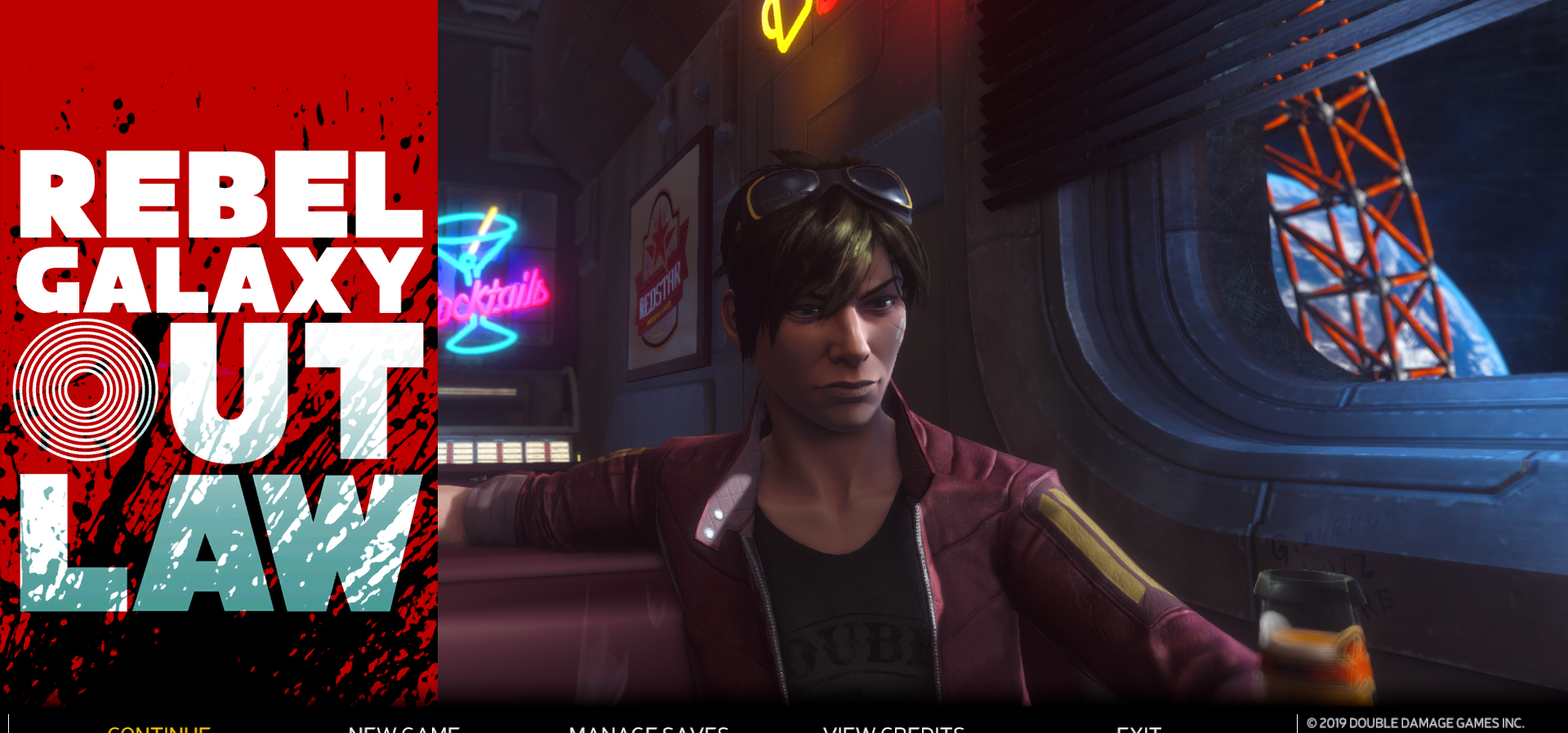









Exceptional review! I think I’ll have to add one more game to my wishlist :3
Thanks Texdade! It’s pretty fun. It has some balance issues with certain mission types toward the end, but overall, pretty darn fun. And for a guy like me, who played Privateer (I put a lot of hours into that game) it was really nice to see someone finally take up the torch.
Hey Colorsfade, Excellent review. Let’s everyone know everything they are in for with this game, and what to expect with the gameplay. Definitely a winner.
Arpeggio
Thanks Arpeggio! I appreciate you swinging by and reading my reviews man! Good to see a friendly face.